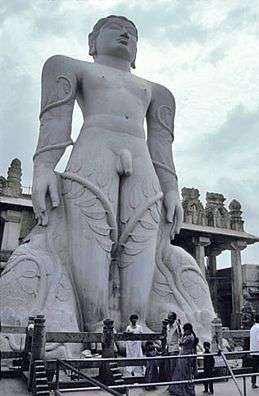Tirtha (Jainism)
In Jainism, a tīrtha (Sanskrit: तीर्थ "ford, a shallow part of a body of water that may be easily crossed") is used to refer both to pilgrimage sites as well as to the four sections of the sangha. A tirtha provides the inspiration to enable one to cross over from worldly engagement to the side of moksha.[1]
| Part of a series on |
| Jainism |
|---|
 |
|
Jain prayers |
|
Ethics |
|
Major sects |
|
Texts |
|
Festivals
|
|
|

Adishwar Temple, one of the Dilwara Temples, Mount Abu.

The Gomatheswara at Shravanabelagola 978-993 AD.
Jain tirthas are located throughout India. Often a tirtha has a number of temples as well as residences (dharmashala) for the pilgrims and wandering monks and scholars.
Types
Tirtha sites include:[2]
- Siddhakshetras or site of moksha liberation of an arihant (kevalin) or Tirthankaras like Ashtapada Hill, Shikharji, Girnar, Pawapuri, Palitana, Mangi-Tungi and Champapuri (capital of Anga)
- Atishayakshetras where divine events have occurred like Mahavirji, Rishabhdeo, Kundalpur, Aharji etc.
- Puranakshetras associated with lives of great men like Ayodhya, Vidisha, Hastinapur, and Rajgir
- Gyanakshetra: associated with famous acharyas or centers of learning like Mohankheda, Shravanabelagola and Ladnu
Locations
Geographically, the tirthas are divided into six quarters:[3]
- North India: Hastinapur, Taxila, and Ashtapada
- South India: Shravanabelagola, Sankighatta, Moodabidri, Humbaj, Anantnath Swami Temple, Gummileru
- Eastern India: Shikharji, Pawapuri, Champapuri, Pundravardhana
- Western India: Palitana, Girnar, Mount Abu, Mahavirji, Shankheshwar, Mahudi
- Central India: Vidisha, Kundalpur, Sonagiri, Muktagiri
- Overseas: Siddhachalam, Nava Ashtapada, Siddhayatan
References
- Special features of sacred places of Jains Archived 2009-04-13 at the Wayback Machine
- Jainism: A Pictorial Guide to the Religion of Non-Violence, Kurt Titze, Motilal Banarsidass; 2nd edition (March 5, 2001)
- Bharat ke Digambar Jain Tirth, Volume 1, Balbhadra Jain, 1974
External links
- jainuniversity.org, Jain Tirtha all over India
- http://www.jainteerth.com
- http://tirth.jinvani.com
- http://www.jainpilgrimages.com
- http://www.jaintirths.com
- http://www.siddhayatan.org First Hindu-Jain Tirth in North America
- http://www.jainheritagecentres.com
- Shri Nageshwar Parshwanath
- Jain Tirth Darshan on jainreligion.in
This article is issued from Wikipedia. The text is licensed under Creative Commons - Attribution - Sharealike. Additional terms may apply for the media files.